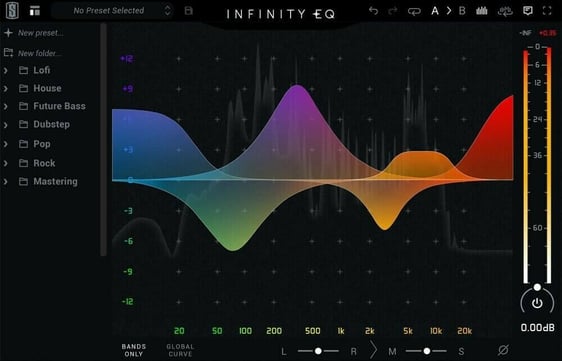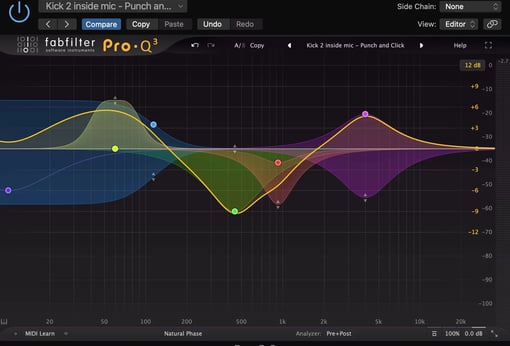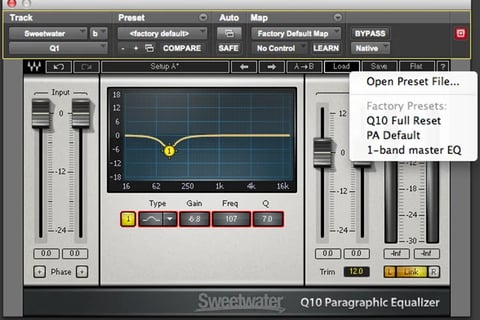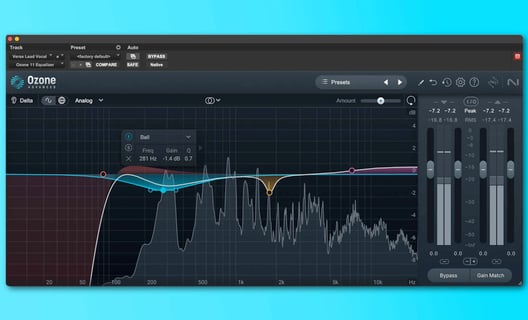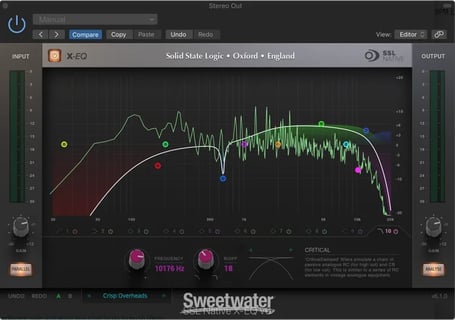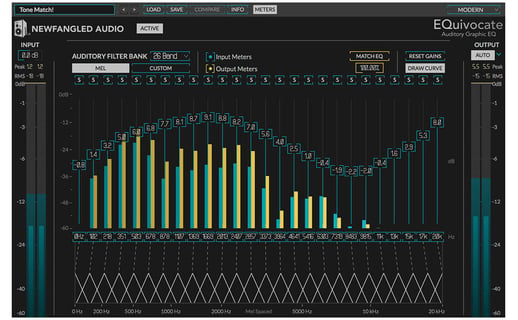Top 5 EQ Plugins for Achieving Perfect Balance
Selecting the right EQ plugin can significantly impact your mixing process and the overall quality of your productions. In this article, we'll explore five top-notch EQ plugins that can elevate your mixes to professional standards. These tools offer a range of features and sound characteristics to suit various mixing scenarios and personal preferences.
PLUGINS
Top 5 EQ Plugins for Achieving Perfect Balance: Expert Picks for 2025
Achieving the perfect balance in your mixes can be a challenging task. EQ plugins play a crucial role in shaping the frequency spectrum of your tracks, helping you create space for each element to shine.
Selecting the right EQ plugin can significantly impact your mixing process and the overall quality of your productions. In this article, we'll explore five top-notch EQ plugins that can elevate your mixes to professional standards. These tools offer a range of features and sound characteristics to suit various mixing scenarios and personal preferences.
1) FabFilter Pro-Q 3
FabFilter Pro-Q 3 stands out as a top-tier EQ plugin for achieving perfect balance in your mixes. Its intuitive interface allows you to quickly shape your sound with precision.
You'll find an extensive array of features, including up to 24 bands of EQ, dynamic EQ capabilities, and a spectrum analyzer. The plugin's surgical precision enables you to make subtle or drastic changes to your audio with ease.
Pro-Q 3 offers multiple EQ shapes, including bell, notch, and shelf filters. You can also use its linear phase mode for minimal phase distortion when making drastic EQ changes.
The plugin's auto-gain feature automatically compensates for volume changes, making it easier to compare your processed and unprocessed audio. This helps you make more informed decisions during mixing.
Pro-Q 3's ability to solo individual frequency bands is particularly useful for isolating problematic frequencies. You can quickly identify and address issues in your mix without affecting the overall sound.
The plugin's mid/side processing capabilities allow you to adjust the stereo image of your tracks. This feature is especially helpful when working with complex mixes or mastering projects.
2) Waves Q10 Equalizer
The Waves Q10 Equalizer is a versatile and powerful plugin that gives you precise control over your audio. With its intuitive interface, you can easily shape your sound to achieve the perfect balance.
This plugin offers 10 fully parametric bands, allowing you to make detailed adjustments across the frequency spectrum. You can fine-tune each band's frequency, gain, and Q factor to target specific areas of your mix.
The Q10 provides a visual representation of your EQ curve, making it easy to see and understand your adjustments. This feature helps you identify problem areas and make informed decisions about your EQ settings.
One of the standout features of the Q10 is its ability to work in stereo or mid-side mode. This flexibility allows you to address issues in the center or sides of your mix separately, giving you even more control over your sound.
The Q10 also includes a real-time analyzer, which displays the frequency content of your audio in real-time. This tool can be invaluable for identifying problematic frequencies and making precise adjustments.
With its low CPU usage, the Q10 is an efficient choice for both studio and live applications. You can use multiple instances without worrying about overloading your system.
3) iZotope Ozone Equalizer
The iZotope Ozone Equalizer is a powerful tool for achieving precise tonal balance in your mixes. It offers both graphic and parametric EQ modes, giving you flexibility in your approach.
You'll find eight bands of fully adjustable EQ, each with its own curve type options. This allows for surgical precision when shaping your audio.
The plugin's intuitive interface makes it easy to visualize and adjust your EQ moves. The spectrum analyzer helps you identify problem frequencies quickly.
One standout feature is the EQ matching capability. This lets you match the tonal characteristics of one track to another, saving time in your workflow.
The iZotope Ozone Equalizer also includes a mid/side processing option. This gives you control over the stereo image of your audio, enhancing width and depth.
You can use the plugin in linear phase mode for transparent adjustments that preserve phase relationships. Alternatively, the minimum phase mode offers a more analog-like sound.
The iZotope Ozone Equalizer integrates seamlessly with other modules in the Ozone suite. This allows for a comprehensive mastering approach within a single plugin ecosystem.
4) SSL Native X-EQ 2
The SSL Native X-EQ 2 is a powerful and versatile digital equalizer plugin. It brings the renowned sound quality of SSL hardware to your digital audio workstation.
This plugin offers 8 fully parametric bands with high and low-pass filters. You can choose between various filter shapes, including bell, shelf, and notch.
X-EQ 2 features an intuitive interface with a large, resizable graphical display. This makes it easy to visualize and adjust your EQ curves precisely.
The plugin includes both a standard and dynamic EQ mode. The dynamic mode allows for frequency-dependent compression and expansion, adding another layer of control to your sound shaping.
X-EQ 2 also provides useful analysis tools. The real-time spectrum analyzer helps you identify problem frequencies quickly.
With its low CPU usage and zero-latency operation, X-EQ 2 is suitable for both mixing and mastering tasks. It delivers the clarity and punch associated with SSL's analog hardware.
5) Eventide EQuivocate
Eventide EQuivocate stands out as a powerful and versatile EQ plugin for achieving perfect balance in your mixes. This innovative equalizer offers 26 bands of EQ, providing precise control over your audio.
EQuivocate utilizes Mel scale filtering, which aligns with human perception of pitch. This approach allows you to make more musical and natural-sounding adjustments to your tracks.
The plugin features a user-friendly interface with a large visual display. You can easily manipulate the frequency bands using intuitive controls and see the changes in real-time.
EQuivocate excels at both subtle tweaks and dramatic sound shaping. Its flexibility makes it suitable for a wide range of audio sources, from vocals to full mixes.
One of the plugin's strengths is its ability to maintain phase coherence. This ensures that your EQ adjustments don't introduce unwanted artifacts or phase issues in your audio.
The Match EQ function is another valuable feature. It allows you to capture the frequency response of one sound and apply it to another, helping you achieve consistent tonal balance across your mix.
Understanding EQ Plugins
EQ plugins are essential tools for shaping and balancing the frequency content of audio tracks. They allow you to enhance or attenuate specific frequency ranges with precision.
What Are EQ Plugins?
EQ plugins are digital audio processors that emulate hardware equalizers. They enable you to adjust the tonal balance of sounds by boosting or cutting specific frequency bands.
These plugins typically display a graphical interface with a frequency spectrum and adjustable bands. You can manipulate these bands to alter the sound's character.
Common types of EQ plugins include parametric, graphic, and dynamic EQs. Each offers unique features and workflows to suit different mixing scenarios.
Importance of EQ Plugins in Mixing
EQ plugins play a crucial role in achieving clarity and balance in your mixes. They help you carve out space for each instrument in the frequency spectrum, preventing muddy or cluttered sounds.
You can use EQ to remove unwanted resonances or emphasize desirable frequencies. This allows you to enhance the natural qualities of each sound source.
EQ plugins also help address issues like masking, where one instrument's frequencies obscure another's. By making precise adjustments, you can ensure each element sits well in the mix.
With proper EQ techniques, you can create depth and dimension in your productions. This leads to more professional-sounding results that translate well across different playback systems.
Tips for Using EQ Plugins Effectively
Proper EQ techniques are essential for achieving a balanced mix. Focus on making precise adjustments and avoiding common mistakes to get the most out of your EQ plugins.
Setting Proper EQ Levels
Start with subtle adjustments. Boost or cut frequencies in small increments, typically 1-3 dB at a time. Listen carefully after each change to assess its impact on the overall sound.
Use a reference track to guide your EQ decisions. Compare your mix to professional recordings in the same genre to ensure your frequency balance is on point.
Prioritize cutting over boosting. Removing unwanted frequencies often yields cleaner results than excessively boosting desired ones. This approach helps maintain headroom and reduces the risk of distortion.
Consider the context of each track within the mix. EQ adjustments that sound great in solo may not work well when all elements are playing together.
Common EQ Pitfalls to Avoid
Don't rely solely on visual representations. Trust your ears above all else. The spectrum analyzer can be helpful, but it shouldn't dictate your EQ choices.
Avoid applying the same EQ settings to multiple tracks. Each element in your mix is unique and requires individual attention.
Be cautious with extreme boosts or cuts. Drastic EQ moves can introduce phase issues and unnatural tonal qualities. If you find yourself making large adjustments, consider addressing the problem at the source.
Don't overuse EQ. Sometimes, proper gain staging, arrangement choices, or recording techniques can solve issues more effectively than heavy EQ processing.
Watch out for frequency masking. Use EQ to create space for each element in the mix by carefully carving out conflicting frequencies between instruments.
